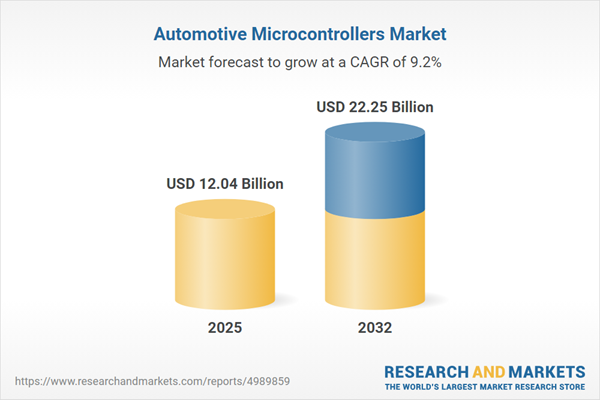Speak directly to the analyst to clarify any post sales queries you may have.
As the automotive sector undergoes rapid digital transformation, automotive microcontrollers are becoming essential for advancing safety, connectivity, and operational efficiency. These systems are foundational to new mobility strategies, equipping organizations to navigate technology change and industry regulation with greater confidence.
Automotive Microcontrollers Market Snapshot
The global automotive microcontrollers market is projected to expand from USD 11.04 billion in 2024 to USD 12.04 billion in 2025, ultimately reaching approximately USD 22.25 billion by 2032, reflecting a compound annual growth rate of 9.15%. This steady growth highlights the pivotal role microcontroller units (MCUs) play in enabling next-generation vehicle platforms and more adaptive operational models. Market drivers include increased digitization within automotive systems, broader adoption of advanced safety and connectivity features, and the evolution of onboard intelligence across combustion-engine and electric vehicle markets. Regulatory dynamics and the increasing prominence of connected, software-driven architectures reinforce the strategic importance of MCUs for automotive manufacturers seeking to maintain compliance and achieve product differentiation.
Scope & Segmentation of the Automotive Microcontrollers Market
This report delivers comprehensive coverage for executive-level stakeholders, aligning analytical focus on critical segments and decision points shaping microcontroller adoption and sourcing strategies. Segment-level analysis is designed to support market entry, partner selection, and investment within varied operational landscapes:
- Architecture: Comparative evaluation of Complex Instruction Set Computing (CISC) and Reduced Instruction Set Computing (RISC) options supports strategic system design and technology integration.
- Distribution Channel: Insights into direct Original Equipment Manufacturer (OEM) channels and aftermarket supply chains, enabling flexible approaches to purchasing and logistics.
- Operating Voltage: Investigation into low, medium, and high-voltage MCUs guides seamless integration for combustion, hybrid, and electric vehicles, aligning with shifting powertrain and compatibility needs.
- End Use: Analysis across passenger and commercial vehicles empowers organizations to tailor digitalization initiatives and operational deployment for distinct fleet requirements.
- Bit Depth: Guidance on 8-bit versus 32-bit controller use cases clarifies selection criteria, from basic control to data-intensive in-vehicle functions such as infotainment and safety management.
- Function: Mapping across core applications, including chassis control, body electronics, telematics, infotainment, powertrain management, and safety, offers scalable frameworks for modular vehicle system development.
- Geographic Coverage: Assessment of trends and operational conditions in North America, Latin America, Europe, Africa, Middle East, and Asia-Pacific, with considerations of local regulation and supply chain composition.
- Company Profiles: Benchmarking of key industry players, including Renesas Electronics, NXP Semiconductors, Infineon Technologies, STMicroelectronics, Texas Instruments, Microchip Technology, ON Semiconductor, Analog Devices, Fujitsu, and Toshiba, covering innovation strategies and global market adaptation.
Automotive Microcontrollers Market: Key Takeaways for Senior Leaders
- Microcontrollers support the integration of next-generation safety, driver-assist, and connectivity features, enabling advanced vehicle intelligence and performance alignment.
- Diversified sourcing strategies, incorporating both global and regional suppliers, help automotive organizations remain resilient during regulatory shifts and supply chain disruptions.
- Investment in advanced, multicore microcontroller platforms elevates real-time analytics and fast response to emerging mobility demands.
- Proactive cybersecurity measures safeguard distributed vehicle systems and complex automotive networks, reducing vulnerability to system-level risks.
- Collaboration between hardware and software teams shortens time-to-market for new technologies and enhances readiness for changing vehicle standards.
- Flexible procurement and compliance models allow manufacturers to continuously adapt processes as regulatory and technology environments evolve worldwide.
US Semiconductor Tariff Impact
Recent US semiconductor tariffs are influencing supply chain management throughout the automotive microcontrollers market. Nearshoring, strategic partnerships with domestic suppliers, and the implementation of robust validation processes are assisting automotive companies in navigating cost fluctuations and regulatory transitions while maintaining operational continuity.
Methodology & Data Sources
The analysis in this report is based on direct executive interviews, critical evaluation of established industry research, and rigorous statistical validation. Methodological rigor ensures findings are reliable and actionable for senior management, providing an accurate representation of industry realities.
Why This Report Matters
- Enables organizations to position their microcontroller strategies in alignment with digital transformation initiatives and automation goals across vehicle platforms.
- Gives senior leadership the insights required to manage sourcing complexity, compliance, and international supply chain issues, supporting seamless operations.
- Facilitates strategic investment decisions with clear mapping of the latest technology directions and evolving regulatory requirements across automotive microcontrollers.
Conclusion
Sustained investment in advanced microcontroller innovation and dynamic sourcing will define competitive advantage for automotive manufacturers. Organizations that adapt to ongoing technology and regulatory developments are best positioned to succeed within digital mobility.
Additional Product Information:
- Purchase of this report includes 1 year online access with quarterly updates.
- This report can be updated on request. Please contact our Customer Experience team using the Ask a Question widget on our website.
Table of Contents
3. Executive Summary
4. Market Overview
7. Cumulative Impact of Artificial Intelligence 2025
Companies Mentioned
The companies profiled in this Automotive Microcontrollers market report include:- Renesas Electronics Corporation
- NXP Semiconductors N.V.
- Infineon Technologies AG
- STMicroelectronics N.V.
- Texas Instruments Incorporated
- Microchip Technology Incorporated
- ON Semiconductor Corporation
- Analog Devices, Inc.
- Fujitsu Limited
- Toshiba Corporation
Table Information
| Report Attribute | Details |
|---|---|
| No. of Pages | 188 |
| Published | October 2025 |
| Forecast Period | 2025 - 2032 |
| Estimated Market Value ( USD | $ 12.04 Billion |
| Forecasted Market Value ( USD | $ 22.25 Billion |
| Compound Annual Growth Rate | 9.1% |
| Regions Covered | Global |
| No. of Companies Mentioned | 11 |









